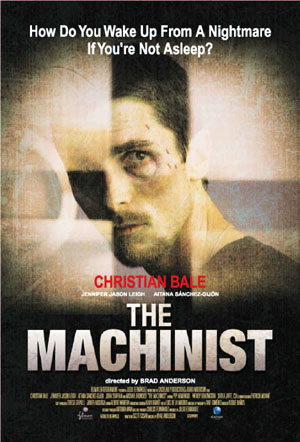The Machinist
The title sequence of the 2005 film The Machinist Dir( Brad Anderson) follows the codes and conventions of the thriller genre. At the beginning of the sequence we see a black screen with the text of the film company but we hear the sound of a pant or someone struggling to breathe this already makes to the audience uneasy as they don't know where its coming from or who it actually is.
The soundtrack is mainly digetic in the sequence, the music is ominous and creepy which creates a thriller atmosphere. Danger is foreshadowed as there are digetic police sirens playing at the beginning of the scene.
As the audience we are watching the protagonist through a window this suggests that we are seeing it from a persons point of view, as it seems like he doesn't know that someones watching him.
Low key lightning is used throughout which creates heavy shadows also shows us the facial expression of the protaganist which makes his face look more creepy.
The sequence is overall slow paced this makes us look at whats going and pay attention to every detail
Cape Fear
The title sequence for the 1991 film Cape Fear Dir(Martin Scorsese) was designed by the graphic designer Saul Bass, he is well known for his geometric shapes and use of bold colours,
This title sequence follows the codes and conventions of thriller genre. The first scene opens on a river current with a reflection of an eagle, eagles are represented as predators and hunt by themselves for prey this suggests foreshadowing as in the film there may be a innocent be attacked by a predator.
As the sequence goes on we see an extreme close up of an eye this shot is effective because it makes the audience feel very uncomfortable. We also a silhouette of a man which hints the narrative of the film. There is a complete change of colour when we see red dipping into the water then the whole screen changes red which symbolizes danger and anger which also links back to the narrative.
The sound track is fast at first then gets slower creating a sense of panic and suspense.The music is played throughout the whole sequence. The music is very effective on creating the mood of the film as it sets a creepy and manic atmosphere.
The typography flows with the rivers current but the font is also sharp and aggressive which fits with the thriller genre.















